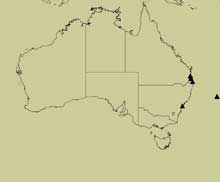Synonyms
Scymnus rostratus Lea, 1929: 243.
Diagnosis
Very similar to P. magnpunctatus but differs in having the pronotum without line separating anterior corners and the abdominal ventrite 1 with numerous small pores associated with postcoxal line.
Description
Length 1.0-1.1 mm. Winged; form elongate oval, convex; surfaces distinctly and uniformly setose with setae mostly suberect and pointing backwards. Brown to dark brown, ventral side testaceous; labrum and appendages yellowish brown. Surfaces between punctures highly polished and strongly shiny. Head flat, regularly punctate and shortly setose, punctures 1-2 diameters apart; each puncture as large as an eye facet, and with a short curved seta. Clypeus distinctly prominent forming short rostrum, weakly arcuate anteriorly. Eyes small, coarsely facetted, dorsally separated by about 4 times width of an eye. Antenna 8-segmented with long 1-segmented club. Pronotum widest just before base and gradually narrowing anteriorly, pronotal margins narrowly explanate and entirely visible from above; anterolateral line indistinct. Disc strongly convex medially, sloping laterally, densely punctate, punctures as large as those on frons, 2-3 diameters apart, laterally punctures becoming slightly coarser and denser. Scutellum oval, well visible, glabrous. Elytron shiny, sparsely and coarsely punctate, punctures irregular and 2-3 times as large as those on pronotum, usually separated by less than one diameter. Elytral margins narrow but entirely visible from above. Epipleuron narrow and extending to level of abdominal ventrite 3. Abdomen: postcoxal line of first ventrite incomplete, not reaching lateral margin, postcoxal disc.
Male
Male genitalia: tegmen 1.1 times, median lobe 1.5 times as long as abdomen; trabes about as long as basal piece; parameres moderately developed, each with single moderately long seta at apex.
Female
Not externally different from male.
Variation
Not observed.
 Distribution and Biology
Distribution and Biology
Widely spread along the eastern coast from southern Queensland to central New South Wales and Lord Howe Island. Adults have been collected in flight intercept traps. The larva is unknown. Click on map for larger version (use the bowser 'back arrow' to return to this page).
Species References
Lea, A.M. 1929. Notes on some miscellaneous Coleoptera, with descriptions of new species. Part VII. Transactions of the Royal Society of South Australia, 53: 203-244.
[ Top ]
